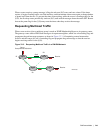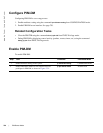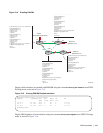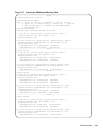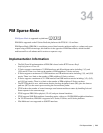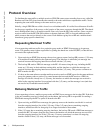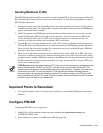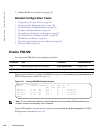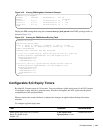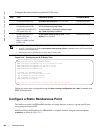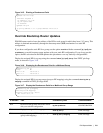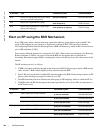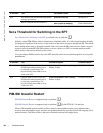
PIM Sparse-Mode | 757
Sending Multicast Traffic
With PIM-SM, all multicast traffic must initially originate from the RP. A source must unicast traffic to the
RP so that the RP can learn about the source and create an SPT to it. Then the last-hop DR may create an
SPT directly to the source.
1. The source gateway router (first-hop DR) receives the multicast packets and creates an (S,G) entry in
its multicast routing table. The first-hop DR encapsulates the initial multicast packets in PIM Register
packets and unicasts them to the RP.
2. The RP decapsulates the PIM Register packets and forwards them if there are any receivers for that
group. The RP sends a PIM Join message towards the source. All routers between the RP and the
source, including the RP, create an (S,G) entry and list the interface on which the message was
received as an outgoing interface, thus recreating a SPT to the source.
3. Once the RP starts receiving multicast traffic via the (S,G) it unicasts a Register-Stop message to the
first-hop DR so that multicast packets are no longer encapsulated in PIM Register packets and unicast.
Upon receiving the first multicast packet from a particular source, the last-hop DR sends a PIM Join
message to the source to create an SPT to it.
4. There are two paths, then, between the receiver and the source, a direct SPT and an RPT. One router
will receive a multicast packet on two interfaces from the same source in this case; this router prunes
the shared tree by sending a PIM Prune message to the RP that tells all routers between the source and
the RP to remove the outgoing interface from the (*,G) entry, and tells the RP to prune its SPT to the
source with a Prune message.
Important Points to Remember
• If a loopback interface with a /32 mask is used as the RP, you must enable PIM Sparse-mode on the
interface.
Configure PIM-SM
Configuring PIM-SM is a two-step process:
1. Enable IPv4 or IPv6 multicast routing using the command [
ip | ipv6] multicast-routing from
CONFIGURATION mode.
2. Select a Rendezvous Point, or let PIM elect an RP. See page 760.
FTOS Behavior: When the router creates an SPT to the source, there are then two paths between the
receiver and the source, the SPT and the RPT. Until the router can prune itself from the RPT, the
receiver receives duplicate multicast packets which may cause disruption. Therefore, the router must
prune itself from the RPT as soon as possible. FTOS optimizes the shared to shortest-path tree
switchover latency by copying and forwarding the first (S,G) packet received on the SPT to the PIM
task immediately upon arrival. The arrival of the (S,G) packet confirms for PIM that the SPT is created,
and that it can prune itself from the shared tree.



